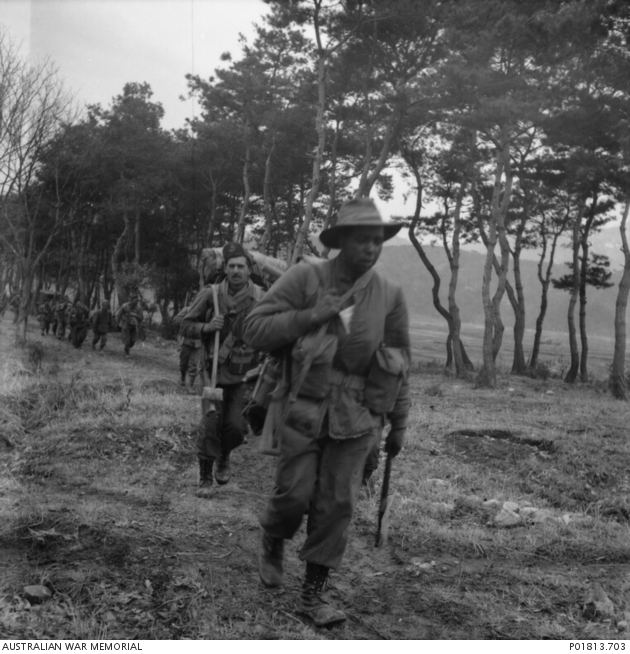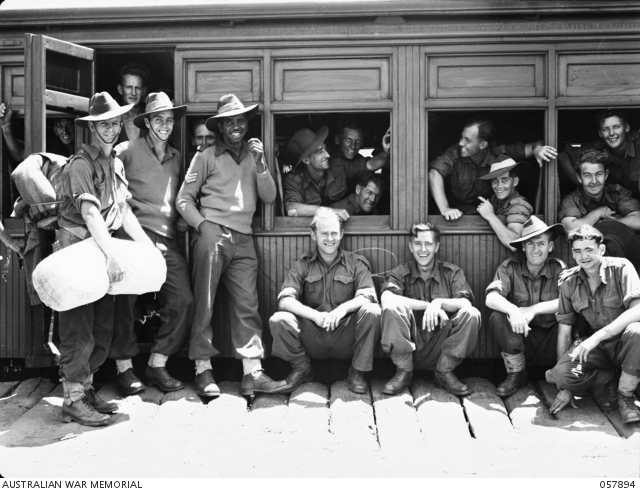Leading from the front
Since the formation of the Australian Defence Force in 1901, many thousands of Indigenous Australian have enlisted and served in all three defence services. The vast majority have served without fanfare. A number have been awarded valour and bravery decorations for their service, but the first to be promoted to a commissioned rank within the Australian army was Reg Saunders. Following in the footsteps of his father and uncles, he served in both the Second World War and the Korean War.
Captain Reg Saunders, then commanding officer of C Company, 3RAR, in the Benton Line area in Korea, March 1951.
Reginald Walter Saunders was born a member of the Gunditjmara people just outside Framlingham Aboriginal Reserve in the Western District of Victoria on 7 August 1920. His father, Chris Saunders, and uncle, William Rawlings, had both served with the 1st Australian Imperial Force (AIF) in the Great War. Reg was named after his uncle, William Reginald Rawlings. He had served with the 29th Battalion AIF and was awarded a Military Medal in July 1918 for “displaying rare bravery in the performance of his duty … His irresistible dash and courage set a wonderful example to the remainder of the team.”
Reg grew to admire the military feats of both his father and uncle. His mother died in 1924, and shortly after her death he and his brother Harry were taken by his father to the Lake Condah Mission, where he received his primary education. He did not like being away from his family, and left school at the age of 14 to work as a mill hand in a timber yard. As his father and his father’s mates talked about the First World War, Reg listened with “ears as big as footballs, taking it all in”.
Listening to all this talk made him want to do the same. When he was given the opportunity to enlist in the Second World War, Reg and his mates “went in swarms” to join up. Reg enlisted in the AIF in April 1940. His outstanding natural leadership skills, personable character and sporting skills were quickly recognised by his army superiors, and he was promoted to the rank of lance corporal within six weeks. Three months later, he was promoted to sergeant.
Reg saw his first fighting in Libya, where he joined the battalion as a reinforcement to the 2/7th Battalion of the 6th Australian Division, and took part inthe continuing push to Benghazi. Following this, on 9 April 1941, he accompanied hisbattalion to Greece, where he took part in the fighting, under constant air attack from the Luftwaffe. The troops soon withdrew and made their way to Crete. On this trip, the ship on which Reg was travelling, the Costa Rica, was bombed and sunk, but he managed to scramble aboard a destroyer.
In Crete, Reg took part in another ill-fated campaign, fighting against the heavy air attacks being inflicted on Allied forces. When they were evacuated from the island, he was one of several thousand troops left behind. Hiding out on the island was a relatively easy task for Reg, who had dark skin and could easily pass for being of Mediterranean descent. After almost a year, in September 1941, he was among troops who were secretly taken off the island by a British submarine.
After returning to Australia, Reg was soon posted back to the 2/7th Battalion and in August 1942 was sent to the Owen Stanley Range in New Guinea. “I preferred fighting in the jungle,” he said. “You had more cover in the jungle. And being a bush boy, I was at home in the jungle, because every time you ducked down you were under cover. In the desert, if you ducked down they’d just bounce bullets off you.”
Troops of the 2/7th Battalion in Innisfail, Queensland, in October 1943. Saunders is third from the left.
It was while he was serving in New Guinea that his brother Harry, who had enlisted close to his 18th birthday with the famous 2/14th Battalion, was killed in action on the Kokoda Trail. It was also while he was in New Guinea that Reg was nominated for promotion to a commissioned rank. He was selected to return to Victoria and attend the Infantry Wing of the Officer Cadet Training Unit at Seymour, Victoria, near Puckapunyal. He graduated as a Lieutenant in December 1944. Reg was the first known Aboriginal Australian to have reached this level of command in the Australian army.
When he heard that Reg had graduated, the secretary of the Aborigines’ Friends Association, Adelaide, the Reverend Gordon Rowe, wrote him a letter of congratulations, to which Reg sent the following letter in reply:
Dear Sir,
Thank you very much for your kind wishes and congratulations.
My philosophy is that once a person undertakes to do something, no matter how big or how small, that person should do it to the best of his or her ability. Which may account for my very small part in helping pave the road to ultimate victory.
Many thanks for your book. Many of the people mentioned in it are very familiar to me.
You mentioned in your letter an attitude towards people of my race. I am sorry, but neither you nor I can change that attitude, because the changing of it rests with the Aborigines themselves, and my contribution towards helping them is just simply by setting myself up as an example – not by words, which are cheap, but by deeds.
Once again, Sir, I thank you, and wish you and your fellow workers all the best of luck.
I remain,
Yours sincerely,
R.W. Saunders
Reg spent the remainder of the war as a lieutenant in charge of an infantry platoon of up to 30 Australians. The irony, of course, is that as an Aboriginal Australian, he did not have the full rights of citizenship that they did. After the war, he was discharged from the army on 5 October 1945 and resumed civilian life. He volunteered for service in Japan with the British Commonwealth Occupation Force (BCOF) but he was rejected, as the government was not considering engaging Aboriginal servicemen for this deployment. He worked in several occupations, including as a builders’ labourer and a shipping clerk, but found it hard to settle down; so after the Korean War started in June 1950, he applied for the Australian Regular Army’s K Force.
Promoted to captain in charge of C Company of the 3rd Battalion Royal Australian Regiment (3RAR), Reg arrived in Korea on 6 November 1950. With this unit he participated in the famous battle of Kapyong on 24–25 April 1951 (reported several times in Wartime, including Issues 34 and 39). Here the Australians spearheaded the British Commonwealth Brigade and succeeded in blocking the Chinese advance on Seoul. It was for this battle that the battalion was later awarded the US Presidential Unit Citation.
Saunders’s souvenir pennant records his service with the 2/7th Battalion during the Second World War.
After Kapyong, and having served 338 days in theatre, Reg finally left Korea in November 1951, and resigned from the regular army in 1954. He moved to Sydney after the war and soon became the captain of his local cricket team and president of a sub-branch of the Returned and Services League. In 1969, he moved to Canberra to work as one of the first liaison officers at the Department of Aboriginal Affairs. He was awarded an MBE for his services on 12 June 1971. Reg was the first Aboriginal Australian appointed to the Council of the Australian War Memorial, in July 1985, and remained in this position until his retirement. Reg Saunders MBE died on 2 March 1990, aged 69.
The Memorial’s National Collection holds several images of Reg, his service medals, an official portrait and some personal effects, such as a 2/7th Battalion pennant and a cigarette case. There is also a picture of him in Korea in the Conflicts 1945 to today gallery. This is an evocative image of Reg doing the hard yards, leading his men literally from the front as his company moves forward. It is symbolic of his career as a soldier, an officer and a public servant. Reg was a pathfinder, a larger than life character – popular, charismatic, good humoured and committed to improving the lives of fellow Australians.


